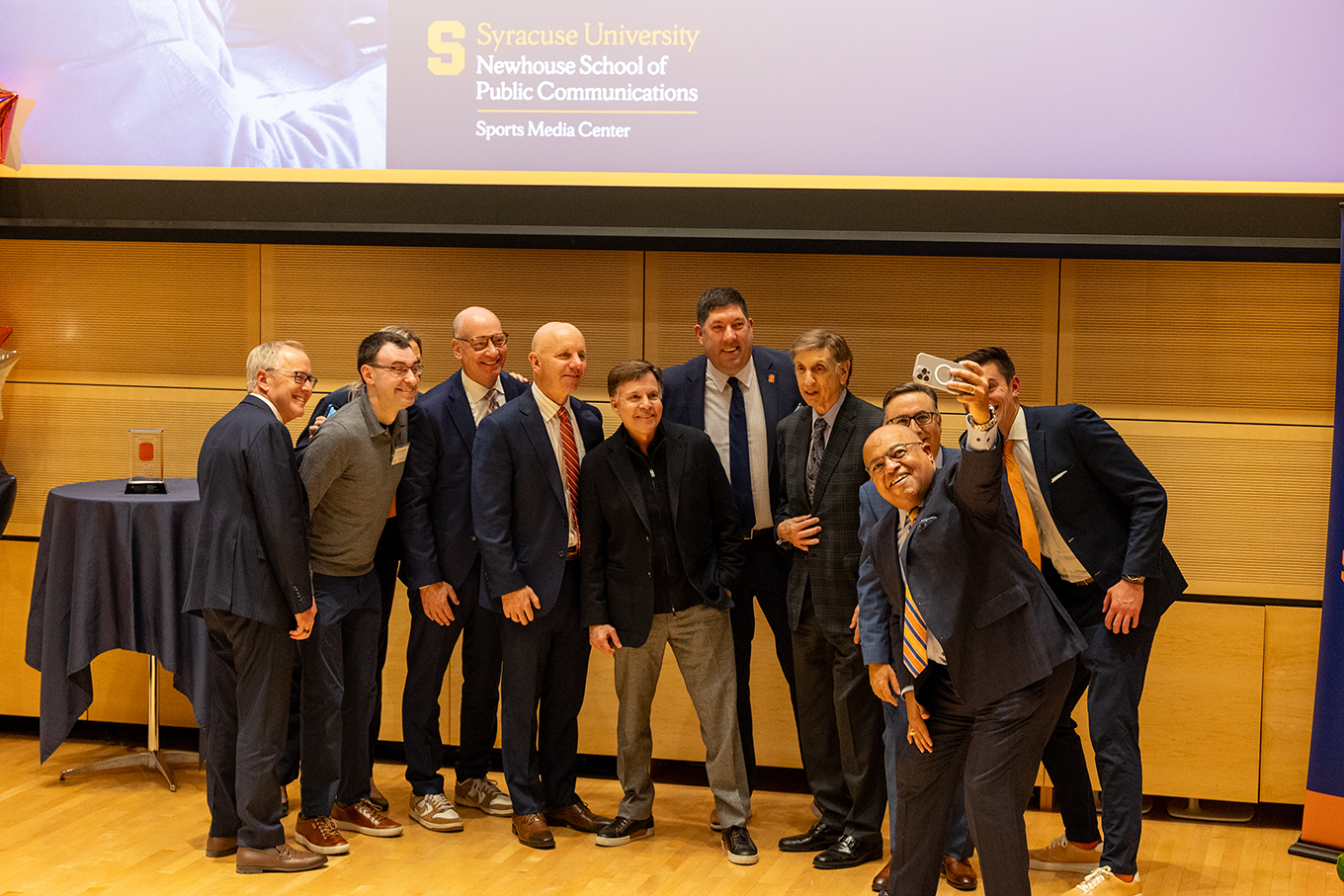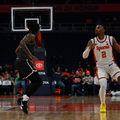Newhouse alums reflect on careers at Legends of Sports Broadcasting conversation

Newhouse School of Public Communications alums Marv Albert, Bob Costas, Ian Eagle and Sean McDonough reflected on their careers at the Legends of Sports Broadcasting Conversation Tuesday. Eli Schwartz | Staff Photographer
Get the latest Syracuse news delivered right to your inbox. Subscribe to our sports newsletter here.
The best sports broadcasters can immerse their audience in the game, making viewers feel as if they are sitting right next to them. On Tuesday, they actually were.
In the Joyce Hergenhan Auditorium at Newhouse School of Public Communications, four of Syracuse’s most famous broadcasting alums came together for the Legends of Sports Broadcasting conversation. The discussion, moderated by Matt Park, featured Marv Albert, Bob Costas, Ian Eagle and Sean McDonough, reflected on the impact SU had on their careers. From the NBA Finals to the Olympic opening ceremonies, the group’s combined experience spans decades of national broadcasts on the biggest stages.
“There’s a standard at Syracuse, that every generation that comes in feels like they need to live up to,” Eagle said. “Usually, it means that you get the best out of people in those situations. Watching, listening to and learning from others continues to be passed down through generations of students.”
They didn’t just become industry legends overnight. All of them shaped their craft during their time at Syracuse.
When McDonough was at Syracuse in the early 1980s, he worked at WAER, Newhouse’s public radio station. At the time, WAER owned the rights to broadcast Syracuse Chiefs games, then the Blue Jays’ Triple-A affiliate. By the time McDonough had graduated from Syracuse, he said he’d broadcasted roughly 400 Minor League Baseball games.
“That was a big head start,” McDonough said. “You have to believe in yourself, and keep working hard at it.”
Costas didn’t hesitate to advise young journalists to focus on building detailed habits, advising younger broadcasters to slow down when calling games and avoid cramming in too much information.
Eagle emphasized the importance of preparation in broadcasting. The product heard in the booth is a result of countless hours of planning, he said, and their effort makes their calls stand out.
“You need to be on top of your preparation,” Eagle said. “I do not procrastinate. I get ahead. I’m usually two weeks ahead in creating the boards I’ll use for the broadcast, then fill in the information as I get closer.”
For McDonough, translating stadium atmosphere is paramount to building context for a broadcast and hooking a viewer. He said he tries to avoid speaking unnecessarily, hoping to immerse the viewer by letting them listen to the band, crowd noise and other game-related sounds.
“I don’t say anything. I let the pictures, video and natural sound carry it,” McDonough said. “It’s one of the reasons why I think most of us talk too much.”

Newhouse broadcasting alums, including Jason Benetti, Sean McDonough, Bob Costas, Marv Albert, Ian Eagle and Mike Tirico pose for a selfie. The group discussed stories from their careers at Syracuse Tuesday. Eli Schwartz | Staff Photographer
Since they began working, the sports broadcasting industry has evolved significantly. While the technology around them changed, Eagle thinks their responsibilities as play-by-play commentators have remained the same for decades.
“I think ultimately the tenets that you go by still ring true,” Eagle said. “You need to be accurate in what you do, to report what you see and to do it professionally. That never changes.”
For SU sophomore Jack Elliott, the conversation was more than just career advice. He said he was inspired by the conversation, and it served as encouragement that students like him could follow in the footsteps of those who came before them and someday find themselves on national TV.
But in Costas’ eyes, the path from student to professional demands more than just admiration. It requires aspiring broadcasters to find their own voice.
“There is nothing wrong in copying the approach of someone you rightly admire or respect,” Costas said. “But that’s just the early stages. If eventually, you don’t find your own voice, you’ll always just be a pale imitation of the master.”
It’s been several years since Drew Carter graduated SU. Now, he’s now the play-by-play voice for the Boston Celtics.
But as he sat in the audience, Carter experienced that same sense of inspiration. Despite being a professional himself, listening to the panel transported him back to his days as a Newhouse student.
“It is a nice little refresher of what really matters,” Carter said. “Working for the Celtics, we’ve got 82 games, and sometimes they come at you fast. Hearing them talk about preparation and slowing down, even the most basic stuff, is really important to be reminded of.”
Eventually, the conversation turned to Marty Glickman, the reason they were all back in central New York. Glickman mentored Albert at Syracuse and instilled the journalistic principles that helped the school become a pipeline for elite sports broadcasters.
Now, his legacy lives on through the Marty Glickman Award for Leadership in Sports Media, an award that honors a sports media professional. All the panelists have won the award before. This year, Park was honored as the recipient at a ceremony directly following the panel.
“(Glickman) touched everybody here, because he was so kind in lending his time to working with broadcasters,” Albert said.






